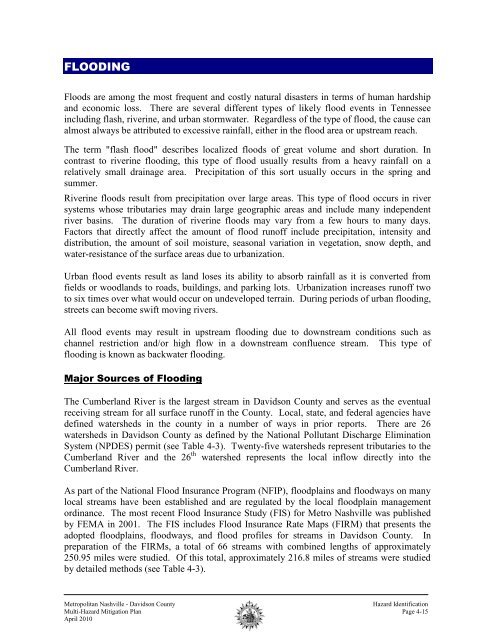2010 Metro Mitigation Plan
2010 Metro Mitigation Plan
2010 Metro Mitigation Plan
Create successful ePaper yourself
Turn your PDF publications into a flip-book with our unique Google optimized e-Paper software.
FLOODING<br />
Floods are among the most frequent and costly natural disasters in terms of human hardship<br />
and economic loss. There are several different types of likely flood events in Tennessee<br />
including flash, riverine, and urban stormwater. Regardless of the type of flood, the cause can<br />
almost always be attributed to excessive rainfall, either in the flood area or upstream reach.<br />
The term "flash flood" describes localized floods of great volume and short duration. In<br />
contrast to riverine flooding, this type of flood usually results from a heavy rainfall on a<br />
relatively small drainage area. Precipitation of this sort usually occurs in the spring and<br />
summer.<br />
Riverine floods result from precipitation over large areas. This type of flood occurs in river<br />
systems whose tributaries may drain large geographic areas and include many independent<br />
river basins. The duration of riverine floods may vary from a few hours to many days.<br />
Factors that directly affect the amount of flood runoff include precipitation, intensity and<br />
distribution, the amount of soil moisture, seasonal variation in vegetation, snow depth, and<br />
water-resistance of the surface areas due to urbanization.<br />
Urban flood events result as land loses its ability to absorb rainfall as it is converted from<br />
fields or woodlands to roads, buildings, and parking lots. Urbanization increases runoff two<br />
to six times over what would occur on undeveloped terrain. During periods of urban flooding,<br />
streets can become swift moving rivers.<br />
All flood events may result in upstream flooding due to downstream conditions such as<br />
channel restriction and/or high flow in a downstream confluence stream. This type of<br />
flooding is known as backwater flooding.<br />
Major Sources of Flooding<br />
The Cumberland River is the largest stream in Davidson County and serves as the eventual<br />
receiving stream for all surface runoff in the County. Local, state, and federal agencies have<br />
defined watersheds in the county in a number of ways in prior reports. There are 26<br />
watersheds in Davidson County as defined by the National Pollutant Discharge Elimination<br />
System (NPDES) permit (see Table 4-3). Twenty-five watersheds represent tributaries to the<br />
Cumberland River and the 26 th watershed represents the local inflow directly into the<br />
Cumberland River.<br />
As part of the National Flood Insurance Program (NFIP), floodplains and floodways on many<br />
local streams have been established and are regulated by the local floodplain management<br />
ordinance. The most recent Flood Insurance Study (FIS) for <strong>Metro</strong> Nashville was published<br />
by FEMA in 2001. The FIS includes Flood Insurance Rate Maps (FIRM) that presents the<br />
adopted floodplains, floodways, and flood profiles for streams in Davidson County. In<br />
preparation of the FIRMs, a total of 66 streams with combined lengths of approximately<br />
250.95 miles were studied. Of this total, approximately 216.8 miles of streams were studied<br />
by detailed methods (see Table 4-3).<br />
<strong>Metro</strong>politan Nashville - Davidson County<br />
Hazard Identification<br />
Multi-Hazard <strong>Mitigation</strong> <strong>Plan</strong> Page 4-15<br />
April <strong>2010</strong>


